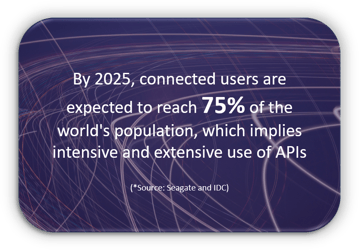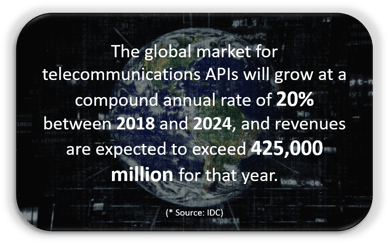
 Many people approach their company’s digital transformation incrementally, as part of a small project or by taking baby steps in areas and stages. Others haven’t started yet, but know that if they don’t integrate that into their client communication/attraction/relationship efforts, among many other basic processes, they will not be competitive and will have to strive hard just to survive.
Many people approach their company’s digital transformation incrementally, as part of a small project or by taking baby steps in areas and stages. Others haven’t started yet, but know that if they don’t integrate that into their client communication/attraction/relationship efforts, among many other basic processes, they will not be competitive and will have to strive hard just to survive.
In this context, why did APIs become key pieces for mid and large-sized businesses?
When firms use business apps to get clear KPIs and all kinds of analytics, they can locate their strengths and weaknesses, as well as demands and changes in the market. By managing data, we can see and hear what clients are looking for, and that feedback prompts your company to think about the user experience and their needs. That’s how you improve in order to keep increasing your turnover and profitability.
-
Arguments for Digital Transformation
 According to consultancy firm Altimeter, customer experience (CX) still leads investments in digital transformation, but as they observed in 2017, employee experience and organizational culture are also becoming increasingly important drivers and accelerators of change, growth and innovation.
According to consultancy firm Altimeter, customer experience (CX) still leads investments in digital transformation, but as they observed in 2017, employee experience and organizational culture are also becoming increasingly important drivers and accelerators of change, growth and innovation.
Some takeaways of Altimeter’s latest survey include:
- Market pressures are the leading drivers of digital transformation, as most efforts are spurred by growth opportunities (51%) and increased competitive pressure (41%);
- Most transformation efforts still focus on modernizing customer touchpoints(54%) and enabling infrastructure (54%);
- CIOs or CTOs (people in charge of systems) are reported as most often owning or sponsoring digital transformation initiatives (28%), while CEOs are increasingly playing a leadership role (23%);
- Almost half of the survey’s respondents reported that they are building as culture of innovation and that in-house innovation teams are becoming the norm. That is how many companies already have created a Digital Transformation Officer/Chief Innovation Officer role to replace the traditional CIO role.
-
The age of recycling
An old idiom warns us not to re-create things that are already there: there’s no need to reinvent the wheel. In business-speak, this means there’s no need to invest in developing objects (products, software, services, etc.) that have already been developed by someone else.
 Almost 20 years ago, companies were wondering whether it was important to have a website. Five years later, the answer was crystal-clear – if you want the world to notice you, you can’t do without one.
Almost 20 years ago, companies were wondering whether it was important to have a website. Five years later, the answer was crystal-clear – if you want the world to notice you, you can’t do without one.
The same thing happened with a lot of business apps. Implementing a CRM project in a small company? No one doubts about that now. ERP and billing systems have also carved out their place. Then, after hitting a certain data volume, big data systems enter the picture.
Thus, the challenge became how to manage data efficiently and make the most of them for your business. This is done online and securely, feeding one system back with data from another and vice-versa.
Back to APIs: what are they and how do they impact on digital marketing? API stands for Application Programming Interface. They enable the “collaboration” between products and services and took data use to the next level, something unthinkable just a few years ago.

-
But… where are they?
In other words, systems with diverse capabilities “lend” those capabilities to other apps through APIs. Thanks to them, for instance, Facebook and Twitter allow you to deploy digital marketing and remarketing strategies by embedding their content on webpages or sharing their data with marketing automation platforms.
These days, everything is done from a device, often a mobile one. Digital campaigns (which involve connections between data, people, systems and various devices) trust APIs. As the innovation rate and the number of connected devices increased, so did the importance of APIs and how they are created, consumed and managed at enterprise scale.
According to the aforementioned Seagate/IDC report, by 2025, the volume of data on the internet will reach 175 zettabytes – ten times the volume created in 2016.
-
Why are APIs essential for Digital Transformation?
Companies also have their own tailored APIs to handle communications between internal sites, webpages and mobile apps. Thanks to them, you can create new kinds of back-and-forth relationships with no need for endless projects.
According to their features, APIs may be used to meet the needs of e-commerce, online payments, social media, cloud computing, and many other areas. Just like Facebook, Google or LinkedIn use their APIs to authenticate users in a social media marketing strategy, for example, so does HubSpot.

-
How can I integrate Hubspot, a corporate marketing software, with other business apps?
HubSpot’s integration capabilities depend, on one hand, of the APIs made available by platforms such as Salesforce, SurveyMonkey, Wistia or GoToWebinar. HubSpot also offers its own APIs for integration with other systems.

Tools such as Timeline API provide access to a contact’s timeline, which allows you to add your own custom events to HubSpot’s registries. The data are turned into a signal to create segmented audience lists, send e-mails for each sub-segment, choose customized content, and a lot more.
Another API, Webhooks, synchronizes data with another app in near-real time. It allows you to create subscriptions to contact/company/deal creations, property updates and deletions in HubSpot. The data are sent instantly to the app online.
-
An agile transformation
So, how do APIs help with digital transformation? They integrate a company’s systems (regardless of their programming language or OS), expose them in a secure way for consumption by web/mobile apps, and streamline processes in all areas, particularly decision making.
The digital transformation or digitalization of processes from every area involves a periodic review of the corporate software architecture, your current business needs and the tweaks you need in order to understand, cater to and grow with your clients. That’s the transformation companies are heading toward in Latin America with their marketing strategy.


Comments